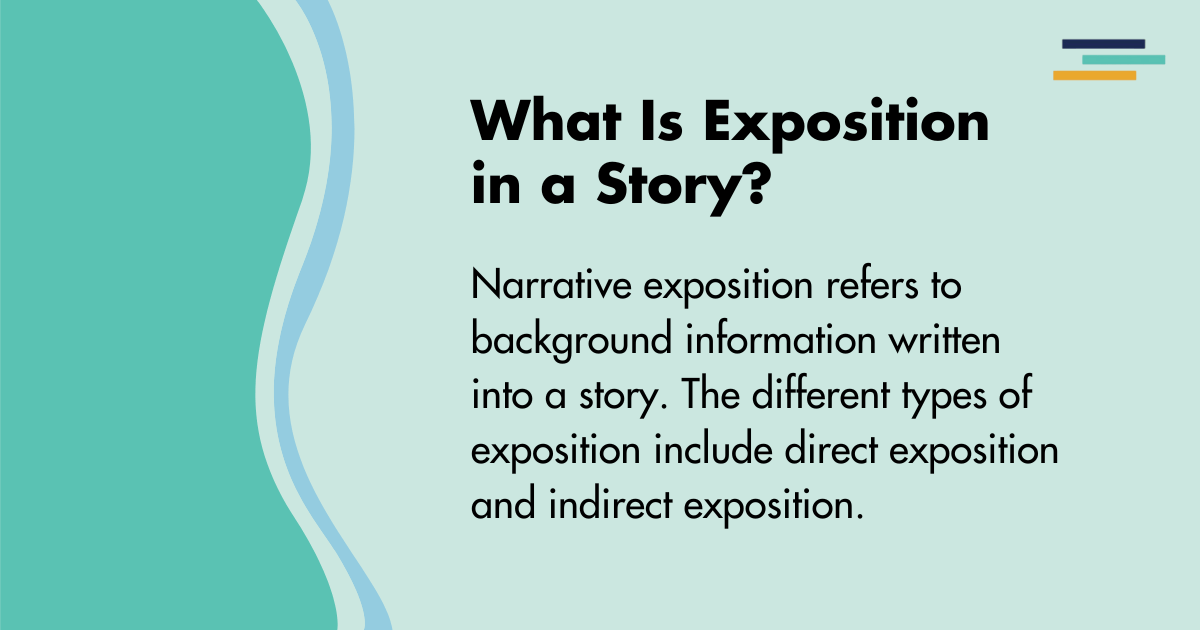
Many writers will be familiar with the dreaded criticism that there is too much exposition.
This article will cover what story exposition is and why it’s often necessary.
We’ll also look at examples of skilfully-crafted exposition within popular novels and cover some tips for writing story exposition well.
What Is the Exposition of a Story?
Narrative exposition refers to background information written into a story. The different types of exposition include direct exposition and indirect exposition.
Direct exposition is telling backstory through your story’s narrative voice.
Indirect exposition includes dialogue exposition, flashbacks and internal monologue.
- Dialogue exposition: when characters engage in dialogue which tells the reader background information.
- Flashbacks: where an event from a character’s past is played out live within the scene, usually through a character’s memory.
- Internal monologue: where a character’s thoughts tell us the necessary background information.

Why Do You Need Exposition in a Story?
Exposition isn’t, in itself, a bad thing. In fact, exposition is absolutely necessary in many stories.
Story exposition helps settings feel real and immersive, and it gives depth to its characters.
Stories are driven by change. We read stories to see how the plot will result in either the characters or their world changing between the narrative’s beginning and end.
To understand how and why this change happens, we usually need to understand something (not everything) of what’s happened before the story’s action takes place.
World Building/ Setting
To take the reader into your fictional world, you’ll need to give them enough background setting information to make your story world seem real and believable, otherwise the reader won’t feel immersed.
You must also provide enough background information to ensure the reader understands enough context to follow the plot.
Character Building
Characters must have history and background if they’re to feel three-dimensional and real. Their past must influence their present, having a strong impact on their goals, motives, wants, needs, and development (or lack of development) throughout the story.
Exposition helps ensure the reader understands your characters’ inner goals and growth arcs, both the motivations your characters explicitly understand, and the more subtle, subconscious motivations they may be unable to articulate.
The difficulty with exposition in a story is that writers walk a delicate tightrope between too much, too little, and just the right amount.
Let’s look at examples of the different types of exposition.

Exposition Example Sentences
Direct Exposition
Direct exposition is when the story’s narrative voice tells the reader something they need to know. For example:
“The prisoner strained against the ropes, pleading with the Detective for his life, but to no avail.
For Detective Inspector Jones was a natural killer, who never felt remorse. Jones knew that killing a criminal was an act of public virtue, nothing like accidental murder. Nothing like that time when he was 17 years old and accidentally ran over some tramp, and then had to join the police force to cover up his crime.
But it turned out the police force was exactly where Jones belonged. It allowed him to carry out justified executions. It allowed him to become, in the eyes of the public, a hero.”
Although this example dips briefly into Jones’ internal thoughts, the narrative voice’s use of irony keeps the reader at a distance from Jones’ interior monologue.
The narrative voice maintains its own voice, separate from Jones’s, letting the reader know that Jones is an experienced and dangerous killer.
Dialogue Exposition
Now, let’s look at an example of dialogue exposition, where information is revealed through character dialogue.
“‘I realised I was a natural killer,’ said Detective Inspector Jones, stroking the gun’s barrel with his fingers, ‘when I carried out my first justified execution.’
The prisoner strained against the ropes.
‘I found it gave me a thrill,’ continued the Detective, a smile dancing at the corner of his lips. ‘And killing a criminal turns you into hero. Nothing like that time back when I was a teenager and ran some tramp over. Had to spend years covering that one up. Of course, I can tell you about it, since you’re good as dead. I’m enjoying watching your reaction.’”
To make expository dialogue work, it must be realistic for one character to impart information to another, less informed character.
It can be difficult to create these conversations without them feeling forced, but it is possible. Think of Dorothy arriving in the Land of Oz, needing Glinda the Good to explain certain basics of the world.
Expository dialogue can be strengthened through careful use of subtext. This extra level of interest can keep the reader engaged.
Flashback
The second type of indirect exposition is flashback. Let’s look at an example.
“Detective Inspector Jones observed the prisoner.
Torn clothes, panic in his eyes, straining at the ropes – useless to resist, though they always tried. They all sweated like him too, that nasty smell of salt, anxiety, and unwashed poverty. Just like that tramp, back in the day. The day Jones realised he’d better join the police force if he was to keep his mistake covered up…
He was only 17 back then, driving home from a party, high as a kite. The grassy tasty of weed on his tongue. The sudden slam, the crash, the jolting force against his neck, the splatter of red against glass…”
To make flashbacks work, you’ll usually identify something in the present scene which makes it realistic for your point-of-view character’s thoughts to jump back in time.
Sensory details can help the memory feel live.
Interior Monologue
And finally, let’s look at interior monologue, our fourth type of exposition.
“The prisoner strained against the ropes.
Jones rolled his eyes. His captives always begged for their lives. A waste of their last breath. They saw his Detective’s clothes, thought he could be bargained with, bribed, reasoned with… The fools. He was jury, judge and executioner.
He hadn’t always been this way, of course. At 17, there was all that worry about the tramp, the stinky one who ran under his car one night. But the tramp had been a scourge on society. Killing him had done the world a favour.
Jones smiled grimly. He was an eradicator of villains. A Hero.”
Here, the narrative voice takes us so deep into Jones’s interior monologue that we lose touch with the narrator. Immersed in Jones’ thoughts, he tells us everything we need to know about his past to feel the tension of the present moment.
Exposition Examples in Literature
Direct Exposition
You can find a famous example of direct exposition in the second line of Charles Dickens’ David Copperfield.
“To begin with the beginning of my life, I record that I was born (as I have been informed and believe) on a Friday, at twelve o’clock at night.”
Our first-person narrator speaks directly to the reader as he records his life story.
This narrative technique is less common in modern fiction than it was in Victorian times. Nevertheless, many modern readers still enjoy these openings.
The opening of Tayari Jones’ An American Marriage provides a modern example or direct exposition.
“There are two kinds of people in the world, those who leave home, and those who don’t. I’m a proud member of the first category. My wife, Celestial, used to say that I’m a country boy at the core, but I never cared for that designation. For one, I’m not from the country per se.”
Both examples introduce us to the protagonists through clear narrative exposition. The protagonists talk directly to the reader through their narrative personas, their opinions formed with hindsight after the story’s events have occurred.
The narrator-protagonists are not giving us an insight into their real-time thoughts in the midst of the story’s action, which would constitute interior monologue.
Dialogue Exposition
An example of dialogue exposition comes from Suzanne Collins’ The Hunger Games, where mentor Haymitch warns our protagonist Katniss and her fellow tribute Peeta what to expect as the Games open:
“Any final words of advice?” asks Peeta
When the gong sounds, get the hell out of there. You’re neither of you up to the bloodbath at the Cornucopia. Just clear out, put as much distance as you can between yourselves and the others, and find a source of water,” he says. “Got it?”
Here, as Haymitch warns Peeta of the bloodbath that will occur at the Cornucopia, we learn a vital piece of background information: the Games will open to a moment of carnage, for which neither Peeta nor Katniss are prepared.
This expository dialogue greatly increases the tension as Katniss and Peeta head towards the Games.
Flashback
Let’s look again at The Hunger Games where Peeta becomes the designated male tribute alongside Katniss.
“Why him? I think. Then I try to convince myself it doesn’t matter. Peeta Mellark and I are not friends. Not even neighbours. We don’t speak. Our only real interaction happened years ago. He’s probably forgotten it. But I haven’t and I know I never will…
It was during the worst time. My father had been killed in the mine accident three months earlier in the bitterest January anyone could remember. The numbness of his loss had passed, and the pain would hit me out of nowhere, doubling me over, racking my body with sobs…”
As this flashback continues, we learn how Katniss’ fellow tribute Peeta, who she’ll need to kill to stay alive in the Games, once saved her when she was starving.
This flashback provides a vital piece of background information, which directly relates to Katniss’ inner conflict as she seeks to survive the Games.
Interior Monologue
Here is another example from The Hunger Games for interior monologue.
“This conversation feels all wrong. Leave? How could I leave Prim, who is the only person in the world I’m certain I love?”
Here, we’re taken straight into Katniss’s interior thoughts to answer the question of ‘why doesn’t she just run away?’
Katniss’s interior thoughts tell us the background stakes, the reason why she must risk her life to save Prim’s because without her, Katniss has nothing left in the world to care for.
Tips for Writing Story Exposition
The general rule of thumb, when deciding how much exposition to provide, is to look at how much is necessary for the story to make sense for the reader – and to give only that, and no more.
But this is standard advice that can feel frustrating to follow.
You may well have received conflicting feedback from different readers as to how much exposition they deem necessary for the story.
As always, at Fictionary, we seek to clarify standard advice by examining it under the lens of the Story Elements.
We’ll look at this question through the three different element groups of Character, Plot and Setting.
How Much Exposition is Right for My Character Development?
Stories are usually driven by the internal and external goals of its characters..
If you’ve not given your reader enough background information to understand the goals and motivations of a scene’s point-of-view character, and the stakes if they fail to achieve these goals, your reader may not understand the story.
The most methodical way to check you’ve included the right amount of exposition is to examine your story on a scene-by-scene basis.
When editing each individual scene, I recommend checking whether you’ve given enough background information for the reader to fully grasp the goals of each scene and how this relates to the protagonist’s overall story goal.
If you haven’t, you may need to provide more exposition, either in this scene or an earlier one, to ensure your characters’ goals, the stakes of failure, and the arising conflict have been made clear.
Any background character information bearing no relation to goals, motivations, or the stakes of failure, may be unnecessary.
Always take into account your story’s genre. A psychological thriller may benefit from deeper exploration of character’s motives than a high-action thriller.
How Much Exposition is Right for My Plot?
A story’s plot is based on characters navigating various obstacles and conflict within their world as they work to achieve their goals.
If you’ve not given your reader enough background information to understand the scene’s conflict, your reader may lose interest as they won’t be able to feel the plot’s tension.
Carry out the same scene-by-scene analysis above, this time checking whether you’ve provided too much, too little, or just the right amount of exposition for the reader to understand each scene’s conflict.
Any exposition which doesn’t strengthen the reader’s understanding of goals, stakes, conflict and tension, should be examined under the lens of setting.
How Much Exposition is Right for My Setting?
If a reader is unable to visualize, understand, believe in, or feel immersed in your story world without being given certain background information, then this exposition is necessary.
You may receive conflicting reader feedback on this point, for different readers require different amounts of setting. You’ll need to use your own artistry to assess what setting exposition is and isn’t necessary.
Remember the importance of genre and story type here.
George Orwell’s literary/ political dystopian novel 1984 contains extensive exposition as appropriate to the genre. His readers want to understand his world’s politics in detail.
Veronica Roth’s Divergent, a high-action young adult dystopian thriller, contains far less exposition. Exposition is provided quickly to ensure the story’s action is tense and its characters relatable.
Look to your comparative titles for guidance on how much setting exposition to use in your story.
How to Integrate Exposition Within a Story
Your artistic skills are required here!
Before providing exposition, you want to hook the reader with a question which makes them desperate to learn the background information you’re about to provide.
Don’t leave answering this question too long, or readers may forget the question altogether or stop trusting you to provide answers.
The above example from The Hunger Games (interior monologue) shows how it’s done. Just as the reader asks the same question Gale does, why doesn’t Katniss just run away?, Katniss’ interior thoughts provide the answer.
Conclusion
Mastering exposition is an advanced writing skill.
It’s unlikely you’ll include the perfect amount in your first draft. That’s why story editing is critical.
Once you’ve broken down your story into separate scenes (which you can do easily through Fictionary’s StoryTeller software), you can then examine each scene to ensure you’ve inserted the right amount of exposition at each point of the story.
You can then also check that exposition is always preceded by relevant hooks.
The right amount of exposition will help your readers feel immersed in your story’s world, connected to your characters, and gripped by your plot.


